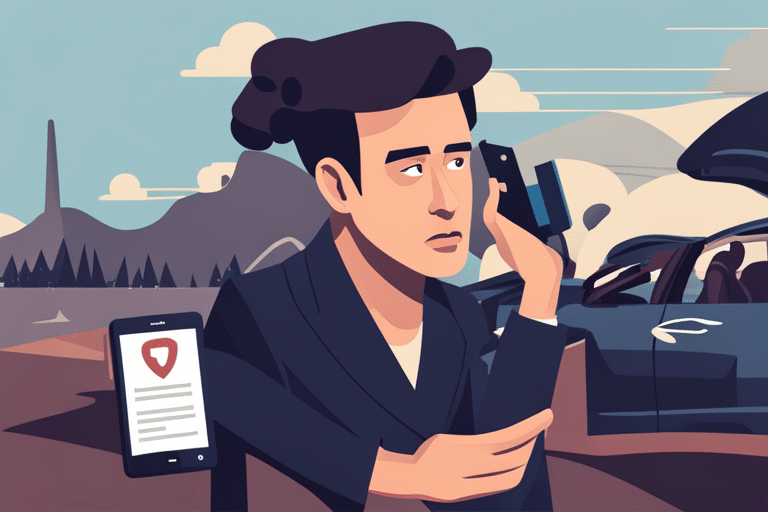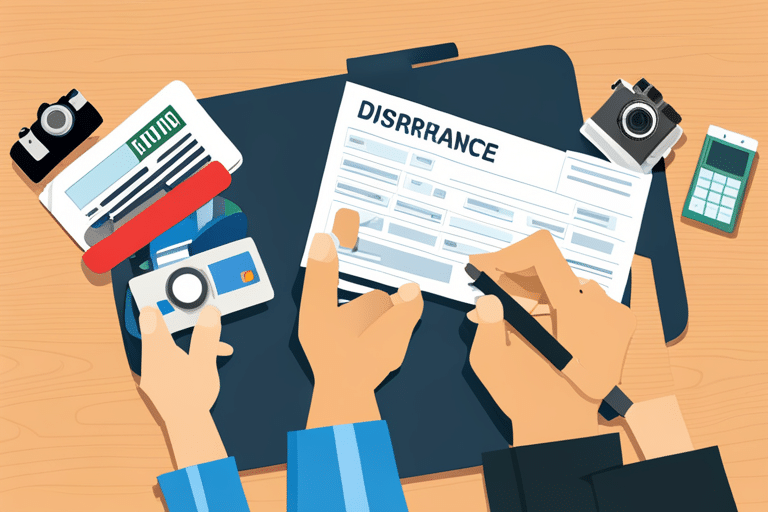Are you feeling lost in the maze of insurance claims after an accident? Don’t worry, we’ve got your back!
Picture this: you, confidently maneuvering through the twists and turns of the claims process like a seasoned pro.
In this guide, we’ll show you how to:
- Gather evidence
- Notify your insurance company
- Deal with the other party’s insurer
- Estimate costs
- Resolve disputes
- And more.
So buckle up and get ready to navigate your way to insurance claim success!
Key Takeaways
- Stick to the facts and avoid embellishments when describing the accident in insurance claims.
- Keep track of all documentation, including photos of the damage, medical bills, and rental car fees.
- Do not accept lowball initial offers from insurance companies and negotiate for a fair settlement.
- Consider seeking legal advice if needed during the insurance claims process.
Understanding the Insurance Claims Process

Understanding the insurance claims process can be confusing, but it’s important to know what to expect. Don’t worry, we’ve got your back! We understand that dealing with insurance companies can sometimes feel like trying to crack a secret code while walking on hot coals. But fear not, fellow claimant! We’re here to guide you through this maze of paperwork and negotiations with a sprinkle of humor and wit.
Now, let’s talk about some common mistakes people make during the insurance claims process. Picture this: you just had an accident, and your car looks like it went through a blender. Your first instinct might be to panic and blurt out every detail of the incident without thinking twice. But hold up! Take a deep breath and remember that less is more when it comes to describing the accident. Stick to the facts, avoid embellishments, and don’t admit fault unless you’re 100% sure.
Here are some tips for maximizing your insurance claim payout: First off, document everything! Take photos of the damage from various angles – even if it makes your car look like a Picasso painting gone wrong. And keep track of all your expenses related to the accident, from medical bills to rental car fees.
Secondly, don’t settle for less than what you deserve. Insurance companies are notorious for lowballing their initial offers, so don’t be afraid to negotiate or seek legal advice if necessary.
Gathering Evidence and Documenting the Accident

Once you’ve collected all the necessary evidence and documented the incident, it’s crucial to inform your insurance provider promptly. Preserving evidence is like holding onto a piece of cake during a food fight – you want to make sure you have proof of what happened, even if things get messy. So grab your Sherlock Holmes hat and start gathering clues!
When it comes to preserving evidence, think about what would impress Judge Judy. Take photos of the accident scene from different angles, capturing every scratch and dent like a true paparazzo. If there were witnesses present (besides the squirrels in the nearby trees), jot down their names and contact information in case they need to testify on your behalf.
Now let’s move on to documenting injuries. Imagine being a master painter creating a detailed portrait of your pain and suffering. Write down every ache, bruise, or twinge you experience as if you’re composing an epic poem about bodily discomfort – just without the flowery language.
To give you an idea of how important documenting injuries can be, here’s a handy-dandy table:
| Injury Type | Description | Severity |
|---|---|---|
| Whiplash | Feels like bobblehead | Moderate |
| Bruised ego | Profound sense of shame | Severe |
| Busted lip | Lipstick smudged | Mild |
| Broken heart | Happened before accident | N/A |
Remember that this table is just an example – please consult with medical professionals for accurate assessments.
Notifying Your Insurance Company

So, you’ve survived the chaos of a car accident and now it’s time to notify your insurance company. But wait, there are some important things you need to know before picking up that phone.
First off, make sure you do it within the required notification time frame or else they might think you’re just calling to chat about the weather.
And secondly, gather all the supporting documentation needed because trust me, they won’t accept a crayon drawing of what happened as evidence.
Required Notification Time Frame
When filing an insurance claim after an accident, you should notify your insurance company within the required time frame. We get it, accidents happen and dealing with insurance claims can be a pain in the rear bumper. But hey, it’s better to be safe than sorry! To make things easier for you (because we’re all about making your life easier), here’s a handy-dandy table that shows the required notification time frames for some common types of insurance coverage:
| Insurance Coverage | Required Notification Time Frame |
|---|---|
| Auto Insurance | Within 24 hours |
| Home Insurance | Within 72 hours |
| Health Insurance | Within 30 days |
Now that you know when to hit that speed dial button on your phone, let’s move on to the next step: gathering all the supporting documentation needed to back up your claim. Trust us, it’ll come in handy during this wild ride called insurance claims!
Supporting Documentation Needed
Alright, now that you know the required notification time frame, let’s talk about the supporting documentation you’ll need to gather for your insurance claim.
I know what you’re thinking: ‘More paperwork? Are they trying to make this process as fun as a root canal?’ Trust me, I feel your pain. But before you start tearing your hair out, let’s break it down together.
When it comes to the insurance claim process, supporting evidence is key. It’s like having a secret weapon in your back pocket (or maybe more like a not-so-secret weapon). This evidence can include things like photos of the damage, witness statements, and even receipts for any repairs or medical expenses. Basically, anything that helps prove your case and shows just how much of a victim you are (cue violins).
Now don’t go overboard with the evidence either; we don’t want to drown them in paperwork. Just gather enough to support your claim and tell your side of the story. Remember, mastering this process means being organized and prepared. So grab that camera (the one on your phone will do just fine), jot down some notes from witnesses (no bribing necessary), and keep those pesky receipts handy.
With all this supporting documentation in hand, you’ll be ready to take on the insurance company like a boss. They won’t stand a chance against your wit and charm (and mountains of evidence). So go forth, my friend, armed with knowledge and paperwork galore!
Let’s show them who’s boss!
Dealing With the Other Party’s Insurance Company

So, you’re ready to take on the big bad insurance company? Good for you!
Negotiating a settlement amount is like haggling at a flea market – be confident, stand your ground, and maybe throw in a little charm.
But before you channel your inner Perry Mason, make sure you gather all the evidence for your claim – pictures, witness statements, and anything else that proves your case.
And if things get really sticky, don’t hesitate to seek legal representation – after all, nothing says ‘I mean business’ like having a lawyer by your side.
Negotiating Settlement Amount
Getting a fair settlement amount for your insurance claim can be challenging, but it’s important to negotiate effectively. Don’t worry, you’ve got this!
Here are some hilarious and effective strategies to maximize your compensation:
-
Channel your inner negotiator: Imagine you’re in a high-stakes poker game, bluffing your way to victory. Show confidence and don’t be afraid to ask for more.
-
Play hardball (but with a smile): Be firm in your demands while maintaining a friendly demeanor. Remember, honey catches more flies than vinegar.
-
Gather evidence like Sherlock Holmes: Present solid proof of the damages and their impact on your life. A deer-shaped dent on your car? Elementary, my dear Watson!
Gathering Evidence for Claim
To gather evidence for your claim, start by taking detailed photographs of the damages and any related injuries. Don’t just go all snap-happy with your phone, my friend. We need high-quality shots here – sharp, clear, and oh-so-detailed. Think of it as your very own photoshoot, except instead of capturing your good side (which is every side, obviously), you’re documenting the aftermath of an accident.
Now, let’s talk about gathering witnesses. No need to hire a detective or put on a Sherlock Holmes hat (unless that’s your thing). Just politely ask anyone who witnessed the accident to share their account of what happened. And hey, if they’re not too keen on talking at first, offer them some cookies or a funny joke – works like a charm!
Lastly, we have accident reconstruction. Now this one might sound fancy pantsy, but fear not! It’s just about recreating the sequence of events leading up to the accident. You can leave out the dramatic music and special effects though (unless you want to make it an Oscar-worthy production).
Seeking Legal Representation
When seeking legal representation, it’s important to find an attorney who specializes in personal injury cases. You want someone who knows the ins and outs of maximizing compensation for your accident.
Here are three things to consider when finding the right attorney:
-
Look for a lawyer with experience: You don’t want a newbie fumbling around with your case like a toddler trying to tie their shoelaces. Find someone who has been around the block and knows their way through the legal maze.
-
Check their track record: Just like when you’re picking a fantasy football team, you want someone who consistently scores touchdowns. Look for an attorney with a proven history of winning cases and getting clients the compensation they deserve.
-
Get personal: No, not in a weird way. You need an attorney who will take the time to listen to your story and understand your needs. A good lawyer will be like your favorite therapist – supportive, empathetic, and ready to fight tooth and nail on your behalf.
Now that you have found the perfect attorney, it’s time to assess the damage and estimate costs…
Assessing the Damage and Estimating Costs

After an accident, it’s important to assess the damage and estimate the costs for your insurance claim. Now, I know what you’re thinking: ‘Assessing damage accurately? Estimating repair costs effectively? That sounds about as fun as watching paint dry!’ But fear not, dear reader, for I am here to guide you through this process with a sprinkle of humor and a dash of wit.
First things first, take a deep breath and put on your Sherlock Holmes hat. It’s time to play detective! Walk around your vehicle and inspect every nook and cranny for any signs of damage. Look out for dents, scratches, or anything that seems out of place. And remember, don’t forget to check under the hood too – who knows what surprises may be lurking there!
Now that you’ve assessed the damage (cue dramatic music), it’s time to estimate those repair costs like a pro. While you could consult a crystal ball or hire a psychic hotline, I suggest taking a more practical approach. Get multiple quotes from reputable mechanics in your area. This way, you can compare prices and make sure you’re not getting ripped off by someone who thinks they have magical powers over car repairs.
With your assessment skills honed and repair cost estimates in hand (or rather, mind), you’re now ready to dive into the next exciting chapter: filing the insurance claim! But hold on tight because this rollercoaster ride is just getting started.
Transitioning seamlessly into our next section about filing the insurance claim… Let’s move forward with confidence knowing that we’ve done our due diligence in assessing the damage accurately and estimating those repair costs effectively. Now it’s time to tackle those paperwork mountains and navigate through the maze of insurance jargon. Buckle up!
Filing the Insurance Claim

So you’ve assessed the damage and estimated the costs. Now it’s time to dive into the thrilling world of filing an insurance claim. But hold on tight, because this is where things can get a little tricky.
First up, you need to gather all the required claim documentation – think receipts, photos, and maybe even a dramatic reenactment of the accident if you’re feeling extra ambitious.
Then comes the claim approval process, which may feel like navigating a labyrinth filled with red tape and paperwork. Just remember to keep your sense of humor intact as you jump through all those hoops – after all, laughter is supposedly the best medicine for dealing with insurance headaches!
Required Claim Documentation
To ensure a smooth insurance claim process, make sure you have all the required documentation ready. Trust me, you don’t want to be scrambling around like a chicken with its head cut off when it comes time to submit your claim. So, what exactly do you need? Here’s a handy-dandy list to help you out:
-
First and foremost, your policy number – without it, you might as well be trying to swim in an empty pool.
-
Next up, any relevant accident reports or police statements – because your insurance company loves reading about your misfortunes.
-
Don’t forget those lovely photos of the damage – they’ll add some much-needed color to the paperwork party.
Now that you know what documents are required, don’t delay! Get them together and submit them pronto. Your claims adjuster will thank you for being on top of things.
And speaking of claims adjusters…
Claim Approval Process
So, you’ve gathered all the required documents for your insurance claim. You’re feeling pretty confident, right? Well, hold onto your hat because now it’s time to dive into the deep end of the claim approval process. It can be a wild ride, my friend.
First things first, understanding claim denial is crucial. Sometimes those sneaky insurance companies will try to wiggle their way out of paying up. But fear not! Armed with knowledge and determination, you can fight back and maximize your claim settlement.
This is where your mastery comes in handy. You’ll need to carefully review your policy and understand what is covered and what isn’t. Don’t let those tricky loopholes catch you off guard!
Now that you’ve got a handle on understanding claim denial and maximizing claim settlement, it’s time to move on to the next step: providing proof of loss…
Providing Proof of Loss

Make sure you’ve gathered all the necessary documents to provide proof of loss after an accident. It’s like being a detective, but instead of solving crimes, you’re trying to prove that your beloved car was indeed damaged or stolen. So grab your magnifying glass and let’s get started!
- Proving Ownership:
- Title or registration: Show them who’s the boss by providing official paperwork that proves you are the proud owner of the vehicle.
- Purchase receipt: Dig deep into those dusty old files and find that receipt from when you bought your car. It’s like finding buried treasure, except it won’t make you rich.
-
Insurance policy: Whip out your insurance policy like a magician pulling a rabbit out of a hat. This document will show that your car was covered at the time of the accident.
-
Assessing Liability:
- Accident report: Get a hold of that piece of paper filled with witness statements and police doodles. It will help determine who is at fault for this mess.
- Photos: Snap some pictures before anything gets cleaned up. They’ll serve as evidence and remind you why you need to invest in a dash cam.
- Repair estimates: Gather quotes from repair shops like they’re Pokemon cards. These estimates will help assess how much moolah needs to be coughed up.
Handling the Claims Adjuster

Dealing with the claims adjuster can be a bit overwhelming, but it’s important to stay calm and provide them with all the necessary information. After all, they hold the key to maximizing your claim settlement. So, let’s dive into the world of handling claim disputes with a touch of humor and wit.
First things first, when you’re talking to the claims adjuster, remember that they’re not your enemy. They might seem like it at times, especially when they start questioning every little detail of your accident. But hey, they’re just doing their job! Take a deep breath and keep in mind that staying cooperative will only work in your favor.
Now, here’s a little secret: documentation is your best friend. Remember those photos you took after the accident? Whip them out! Having visual evidence can help support your claim and make it harder for any disputes to arise. And don’t forget about those medical bills and repair estimates – gather them up and present them like a boss!
But what if you find yourself facing off against an unyielding claims adjuster? Well, my friend, this is where mastering some negotiation skills comes in handy. Be persistent yet polite; show them that you mean business without being rude or pushy. And if all else fails, consider seeking legal advice from professionals who specialize in handling claim disputes.
Negotiating a Settlement

When negotiating a settlement, it’s important to clearly communicate your needs and expectations. After all, you’re not just settling for anything less than what you deserve! So buckle up and get ready to navigate the wild world of settlement negotiations with these witty tips:
-
Prepare Like A Pro: Before you dive into the negotiation ring, do your homework. Gather all the necessary documents, evidence, and even some popcorn because this could be a show! Show them you mean business by being prepared.
-
Play Hardball (but with a Smile): Negotiating is like a game of poker. Keep a straight face but don’t forget to smile occasionally. It confuses your opponent and makes them wonder if they’ve underestimated you. Let them sweat!
-
Ask for More Than You Want: This may sound counterintuitive, but aim high when stating your initial offer or demand. It gives you room to negotiate down while still getting what you really want. It’s like asking for extra fries at the drive-thru – who knows, they might just give it to you!
Remember that every negotiation is different, so adapt these strategies as needed. But above all else, stay confident in yourself and your abilities to get what you deserve.
Resolving Disputes and Appeals

So, you’ve negotiated a settlement with your insurance company and thought everything was finally resolved. But then, to your dismay, they made a decision that didn’t quite sit right with you. Don’t panic! It’s time to delve into the world of resolving disputes and appealing decisions.
Now, let me paint a picture for you. Imagine this scenario: You’re sitting at your kitchen table, scratching your head in confusion over what to do next. Your insurance company has denied your claim for damages caused by an accident that wasn’t even your fault (cue dramatic gasp). What’s a savvy individual like yourself supposed to do?
Well, fear not! I have just the solution for you. Allow me to introduce the magical tool called “Resolving Disputes and Appeals.” This nifty little process allows you to challenge the decision made by your insurance company and fight for what is rightfully yours.
To help you understand this process better, I’ve prepared a handy-dandy table for you:
| Step | Action | Outcome |
|---|---|---|
| Step 1 | Review your policy | Discover any clauses supporting appeal |
| Step 2 | Gather evidence | Build a strong case |
| Step 3 | Contact your insurer | Express dissatisfaction |
| Step 4 | File an official complaint | Escalate the issue |
| Step 5 | Seek legal advice if necessary | Get professional help |
Think of this table as your trusty roadmap in navigating through the murky waters of resolving disputes and appeals. Each step is designed to steer you towards justice and ensure that your voice is heard.
Timeframes and Deadlines for Insurance Claims

Now, let’s talk about the timeframes and deadlines that you need to be aware of when it comes to your insurance claims. Don’t worry, we won’t bore you with a long lecture on this topic. Instead, we’ll give you a quick rundown in our signature witty style.
Here are three important things you should know about timeframes and deadlines for insurance claims:
-
Required Claim Forms: Ah, paperwork! The bane of our existence. Well, guess what? Insurance claims require some paperwork too. You may have to fill out claim forms, which are like those annoying questionnaires from your high school days. But hey, they’re necessary evil if you want that sweet claim settlement.
-
Claim Settlement Timeframe: Patience is a virtue they say, but let’s be honest – waiting for an insurance claim settlement can test even the most zen-like among us. The good news is that there’s usually a timeframe within which the insurance company must settle your claim. So sit back, relax (or not), and keep an eye on the calendar.
-
Don’t Miss Those Deadlines: Picture this: You’ve filled out all the required forms and submitted them promptly. You’re feeling pretty proud of yourself until…BAM! You realize you missed an important deadline. Uh-oh! Don’t let this happen to you! Stay vigilant and make sure to meet all the deadlines set by your insurer.
Dealing With Uninsured or Underinsured Motorists

If you ever find yourself involved in an accident with an uninsured or underinsured motorist, it’s important to gather as much information as possible for your own protection.
Now, I know what you’re thinking – ‘How on earth am I supposed to do that when all I can think about is the crumpled mess my car has become?’ Fear not, my friend! I’m here to guide you through this sticky situation with a dash of humor and a sprinkle of wit.
First things first, let’s talk about those hit and run accidents. You know, the ones where the other driver zooms off like they’re auditioning for the next Fast and Furious movie. It’s like playing hide-and-seek with a really bad driver. But fret not! Take a deep breath, channel your inner Sherlock Holmes, and start gathering clues. Jot down any details you can remember – license plate number (if you managed to catch it), car make and model (unless they were driving a UFO), and any distinguishing features (like bumper stickers proclaiming their love for kale smoothies).
Now onto recovering that uninsured motorist coverage. Think of it as unleashing your inner superhero – Insurance Man or Wonder Woman! Call up your insurance company faster than The Flash at happy hour and let them know what happened. They’ll guide you through the process of filing a claim and provide all the necessary forms faster than Superman racing against an F1 car.
Protecting Your Rights and Seeking Legal Assistance

When you find yourself in a situation where you need to protect your rights and seek legal assistance, it’s crucial to reach out to an experienced lawyer who can guide you through the process. Trust me, navigating the legal system can be as confusing as trying to assemble IKEA furniture without the instructions. But fear not! With the right legal assistance, you can confidently tackle any legal issue that comes your way.
To help paint a picture of what protecting your rights and seeking legal assistance entails, here are three key steps you should keep in mind:
- Understand Your Rights:
- Wrap your head around the specific laws that apply to your situation. It’s like deciphering a secret code, but luckily lawyers have cracked this code long ago.
- Don’t let anyone trample on your rights! Stand tall like an oak tree during a storm and assertively defend what is rightfully yours.
-
Consult with someone knowledgeable about the law who can guide you through the ins and outs of protecting your rights. Think of them as a wise Yoda guiding you through the treacherous swamps of legality.
-
Explore Your Legal Options:
- It’s important to know all your options before making any decisions. Just like choosing which pizza toppings to get (always go for extra cheese), understanding your legal options allows you to make informed choices.
- Research different approaches available for resolving your issue and weigh their pros and cons. Remember, knowledge is power!
-
Seek advice from an experienced lawyer who can provide insights into potential courses of action based on their expertise.
-
Find an Experienced Lawyer:
- Just like finding Nemo in a vast ocean, locating an experienced lawyer requires some effort but is totally worth it in the end.
- Look for someone with a proven track record, like Indiana Jones hunting ancient artifacts or Sherlock Holmes solving mysterious crimes.
- Make sure they understand your concerns, communicate effectively, and have your best interests at heart. You want a legal superhero in your corner!
Frequently Asked Questions
What Should I Do if the Insurance Company Denies My Claim?
If the insurance company denies your claim, don’t panic! You have options. First, gather evidence to support your case. Then, follow the appeals process outlined by the insurer. If all else fails, consider pursuing legal action. Keep fighting for what’s rightfully yours! #InsuranceBattle
Can I Still File an Insurance Claim if I Don’t Have All the Necessary Documentation?
Don’t fret if you’re missing some paperwork for your insurance claim! There’s always a way around it. Discover the power of alternative evidence and learn how incomplete documentation impacts your claim. Stay tuned!
How Long Does It Typically Take for a Claim to Be Processed and Settled?
On average, it takes a bit of time for your claim to be processed and settled. But don’t worry, delays are common! So sit back, relax, and try not to pull out any more hair while you wait.
What Are My Options if the Other Party’s Insurance Company Refuses to Cooperate?
If the other party’s insurance company refuses to cooperate, you have options. You can explore legal recourse or seek third-party assistance. Don’t let their stubbornness rain on your parade, fight back!
What Steps Should I Take if I Suspect the Insurance Company Is Acting in Bad Faith?
If you suspect the insurance company is acting shady, it’s time to fight back! Seek legal advice and explore your legal recourse. Don’t let those sneaky insurers get away with bad faith tactics!
Conclusion
So, there you have it! Navigating insurance claims post-accident may seem like a daunting task, but fear not! With a little bit of patience, some solid evidence gathering skills, and the help of your trusty insurance company, you’ll be back on track in no time.
Remember to notify both your own insurance company and the other party’s company (if there is one), assess the damage with a keen eye, and don’t forget about those pesky deadlines.
And hey, if all else fails, seek legal assistance – because sometimes you just need a superhero cape to save the day!

